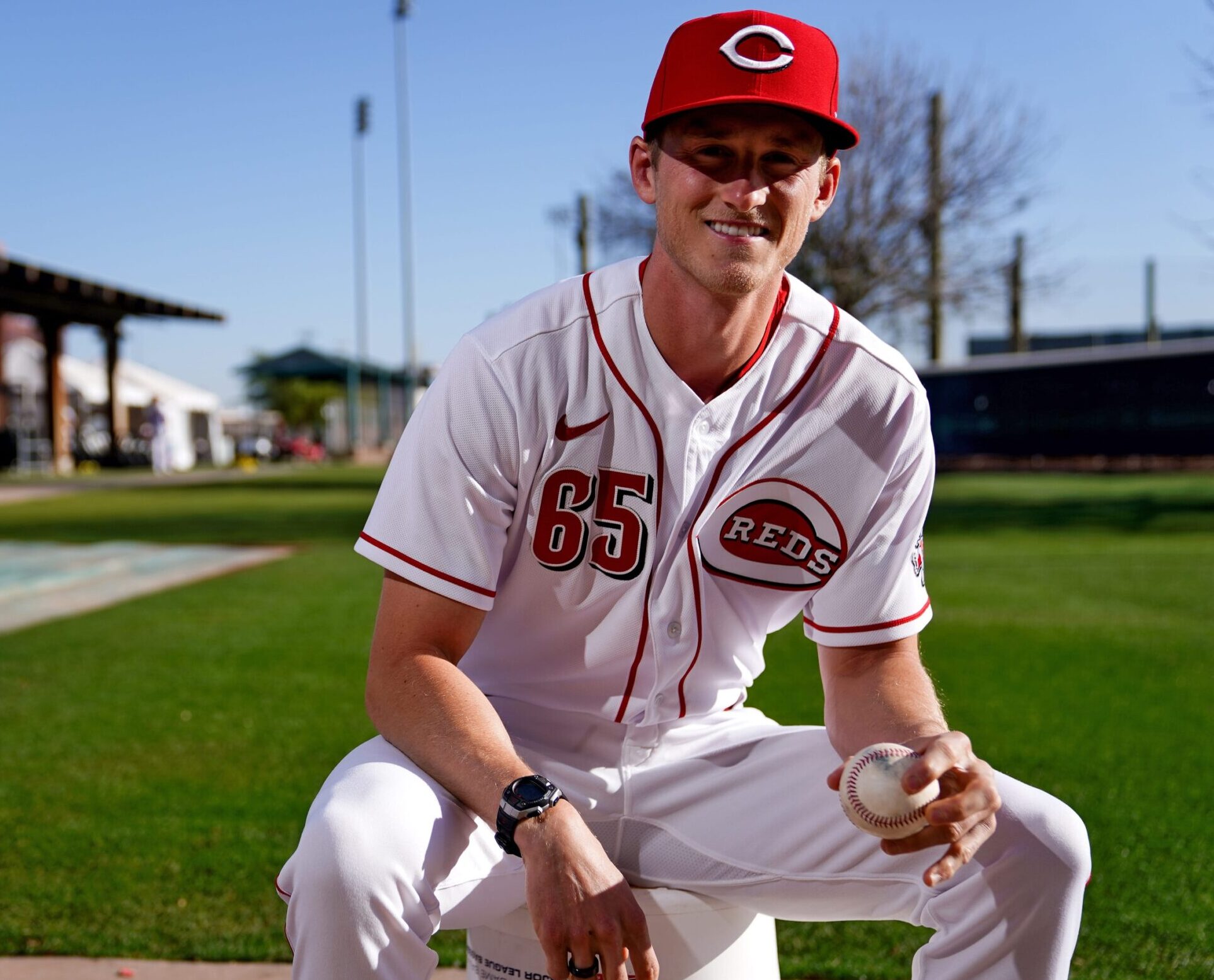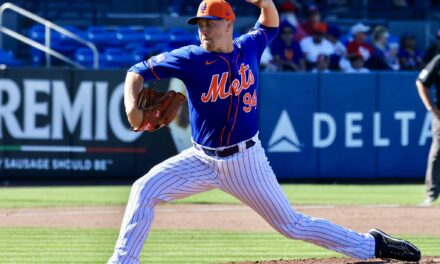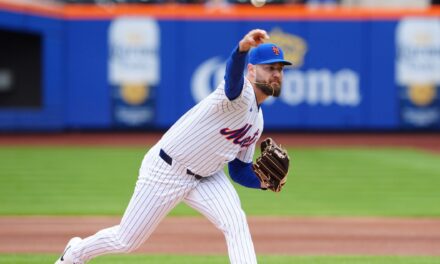
Source: The Enquirer
In early November, the New York Mets made a hire that may have gone unnoticed and isn’t as acclaimed as the announcement of a major free-agent signing or trade.
At the General Managers’ Meetings in Las Vegas, Mets GM Billy Eppler announced the Mets had hired Eric Jagers as their director of pitching development.
Some of Jager’s responsibilities include overseeing the Mets’ minor-league pitchers, working with major-league pitching coach Jeremy Hefner and providing assistance and support to the coaching and instructional staffs across the organization.
Jagers, 27, already boasts quite an impressive resume in a short amount of time in the game.
His career began as a left-handed college pitcher with aspirations, like so many, of getting drafted. Unfortunately, injuries arose including a torn labrum and developing thoracic outlet syndrome, so his attention turned from pursuing a playing career to a coaching/instructional one.
While rehabbing and trying to get back on the field, Jagers trained at Driveline, the data-driven facility in Kent, Washington, and became enamored with what they were doing with data and tech, such as Rapsodo and Edgertronic.
Jagers began working at Driveline as their manager of technical development in January 2018, followed by an advisory role as assistant director of pitching.
Through collaboration and a lot of trial and error, Jagers became more and more fluent and familiar with Driveline’s methodologies, technologies and biomechanics work. There, Jagers delved into pitch design by utilizing slow and high-speed footage and overlay videos to help tinker with grips, seam orientation, etc.
While his pursuit of pitching in a major league organization did not come to fruition, it didn’t take long for the Iowa native to find himself working for a major league team, as the Philadelphia Phillies hired him as a pitching strategist prior to the start of the 2019 season.
During his lone season in the Phillies organization, Jagers was responsible for integrating technology for pitching development across the minor leagues, as well as working alongside affiliate coaches, R&D staff, and the front office and baseball operations team.
The Reds came calling for Jagers in November 2019, hiring him as their assistant pitching coordinator. Jagers would work under Driveline’s founder Kyle Boddy, who was hired as the team’s director of pitching initiatives and pitching coordinator just two months prior. After working one season in that role, the Reds promoted Jagers to assistant major league pitching coach.
The hiring of Jagers to oversee the pitching development of the Mets’ minor league system is yet another example of how the organization under Steve Cohen is continuing to increase its presence in the use of data and analytics.
With many young prospects coming into professional ball with an increased knowledge of modern analytics, hiring a wunderkind, who not only has the data/biomechanics foundation but is lauded for his communication skills, can work wonders for aiding in future development.
I had the privilege of speaking to Jagers shortly after he was hired by the Mets, to discuss his time at Driveline, work with the Phillies and Reds and new role as director of pitching development.
MMO: Can you talk a bit about your playing career?
Jagers: [I] played in junior college and got hurt. I got surgery on my labrum and then rehabbed. I came back and there was still some lingering pain and ineffectiveness as a pitcher.
I took a year off [from pitching] at Driveline, and ended up transferring to Iowa and got hurt right away; I was only there for a semester. It wasn’t a re-aggravation of the same injury but a different one, I had thoracic outlet syndrome. That set me up to be old for the upcoming draft and I literally had no more redshirts to spend.
I left in a good spot with the coaching staff. It was like hey, go give my money to somebody who’s going to help the team win, sort of deal.
MMO: So, you initially got involved with Driveline in college?
Jagers: Yes. I researched the program and got introduced to some of the concepts in modalities as we were training in the fall of my freshman year.
Nothing wrong with how it was implemented but I would say that once I dove into the actual research and how they were going about the training from Driveline and found it from the source, I found things that were a bit different.
That’s how I sort of rebuilt myself from a rehab standpoint by using their methods.
MMO: Were you someone that was interested in data and tech growing up?
Jagers: I wouldn’t say so. I was pretty prototypical; I played a ton of Wiffle ball and was always at the community pool. I was generally creative and exploratory in nature but wouldn’t say it was geared towards the science-side or data and technology. I was never a standout student or anything.
I saw benefits of it being able to help pitchers and I honestly did not benefit all that much from the data analytics. It was still very much in its infancy.
Towards the tail-end of my playing career was when things like Rapsodo were starting to pop up but it was still very, very new on the scene.
Certainly, there were teams that were already ahead of the curve. Things like PITCHf/x and data was publicly available and probably being studied by people who came before like a Mike Fast and Josh Kalk; guys who were far beyond their years.
For myself, it was probably more in that realm from a player evaluation and acquisition standpoint, and way less about development. I felt like that stuff really hadn’t been there which is crazy to think about when we’re only talking about five or six years ago.
MMO: At what point did your mindset change from pursuing a playing career to focusing on a coaching/instructional one?
Jagers: It was definitely in the fall at Iowa in 2017. I would say I got a taste of being a player/coach when I was down and nursing my shoulder/neck [injury]. I was still around and trying to help the guys.
It was there where I started to see real-time changes and guys benefiting from the information. That’s kind of where I got the validation and it became fun for me and thought it might be something I could pursue.
MMO: What would you say were some of the bigger takeaways and areas where you grew the most while training and working at Driveline?
Jagers: If I had to point to one thing in particular, I think it was just being a product of the people around me.
I don’t think it’s any secret about the talent that’s come out of there. Being around like-minded individuals, obviously Kyle [Boddy] has been an inspiration for me, but also the likes of Jason Ochart, Sam Briend and Rob Hill.
That’s what really sticks out and where I was able to push myself further and expand the knowledge base.
MMO: For many, the different metrics and technologies that provide an abundance of information and data can be overwhelming. How did you go about learning and utilizing the various data and implementing it on an individualistic basis with players?
Jagers: Probably through failing a lot and using it the wrong way. Fortunately, we had the literal lab setting [at Driveline] and it was on a bit smaller scale; not having the scrutiny of media and not at the expense of hugely valuable games and organizations.
I would say I was able to experiment on myself a fair bit. There’s certainly things I can look back on a couple of years ago where it’s like man, the way we were doing that just wasn’t right, and we wouldn’t do that now. It sucks when you think about it that way a bit, but I think it’s also healthy to look back and reflect and see that you’ve grown.
I hope I say that in a couple of years too, when we look back to this now and say, I could’ve done that a little better, but we’ve moved forward.
MMO: You’re someone that has been commended for not just the ability to understand and break down data, but to communicate it and present it in a way that makes players buy into and want to incorporate it. Was that something you were naturally good at, or did it take some time to be able to balance both aspects?
Jagers: I think that part does come naturally to me. I would say generally I feel like I am a caretaker and often thinking of others before myself. I’m often trying to think for them and think long and hard about what is best. And that can also be not delivering the information. What’s the right time to give this to the guy? What’s the right place? Right setting? Is he in the right frame of mind? That certainly is where my head goes a lot of the time.
I think some of that is from failure and experience and having missteps at times, or putting something into play and it’s like, okay, that wasn’t it.
I’m really diligent about my documentation and reflection on those things so that I was able to learn from both success and failures. If something worked and succeeded, hopefully we can make that happen more in the future and make a note of it. And if it failed, hopefully we can have less of that in the future because we’re aware of it.
It’s kind of that black box thinking, it makes me think of that book by Matthew Syed (“Black Box Thinking“), where failure is not a bad thing but it’s about making sure you’re on top of the process of what happened. It also makes me think of a Sherlock Holmes-ism to where it’s like, everything under the sun has been done and will be done again.
You can certainly learn from the past and really should lean on it.
MMO: One of the things that you’re well-known for is your work with pitch design. Did that fascination begin with your deep dive into Rapsodo and Edgertronic? And can you talk about some of the characteristics and traits you look at when reviewing pitch design?
Jagers: It was something that was fascinating to me. Pitch design is something that’s been done for many, many years but just less efficiently due to lesser resources. All we’re doing now is streamlining it and adding more technology.
If you talk to older coaches or guys who played before, guys have always been tinkering with grips, shapes, and things like that. We are really fortunate to be able to have a better understanding of how the best pitches in the world from the best pitchers in the world move. It makes it really easy on us.
It’s definitely something that I saw value in really early on and it was like oh, wow, we have to scale this out!
It’s funny to see the cameras get carried around and things like that. I’m not saying that people aren’t careful with the technology because everyone’s got a really nice Pelican case and they carry it out with a tripod and often with a team of people. When I was first using these cameras, they are $5,000 for the base model of Edgertronic. And to me, that might as well have been five million dollars. [Laughs.] I’m carrying this camera with my life and I’m so scared.
At Driveline, we had a special model that Edgertronic gave us to test which is called the SC2X. That camera ran over $20,000. I’m carrying this thing around, which is for sure more money than I had in my bank account; my net worth is less than the camera that I’m carrying! [Laughs.] You can imagine how I felt.
I was just going to the University of Washington baseball games and not necessarily filming pitch design, but getting high-speed footage of side angles and front view of the ball coming into the batter’s path. I would just watch the video for hours on end and be fascinated. Obviously, we’re using a bullpen setting but then we’re able to use it in a game setting and you’re just like, wow, the possibilities are endless here.
It was something that was fascinating to me. When you sort of dive into the arsenal as a whole and you’re starting to build this toolbox for pitchers, it becomes really fun.
MMO: And the work with pitch design started at Driveline, right?
Jagers: Yeah. And let me tell you, Rapsodo, and they would be the first to say this too and we have a great relationship, but it was really tough sledding early on trying to validate it and get it to read accordingly and move from the 1.0 to the 2.0 to the 3.0. That’s the healthy growth and iteration. But being there on the ground floor, we certainly spent a lot of time in the lab trying to get that stuff to work and that goes for Edgertronic, too.
The processes that exist right now to where it’s all auto-triggered and it syncs with Trackman is really nice, and it goes into the dashboard and can view it on the spot. It’s linked to the pitch data. We were spending so much time and manpower on linking these things up, manually inputting the pitch metrics on top of video, learning Final Cut Pro and video editing so that we were able to put together side-by-sides and overlays so we could serve the players as best as possible.
All that stuff is automated now. You look at it and I certainly left the journey in a better place but the guys at Driveline have continued to push forward, and I think hold the gold standard for the process in place.
MMO: How did the pitching strategist role with the Philadelphia Phillies come about in 2019?
Jagers: I was just approached. Jason Ochart had recently been hired in 2019 and he was at spring training, and I had gotten approached from my bosses at Driveline about a potential opportunity. I was all ears and I think I was really eager to be a part of a team or an organization to where I could get back onto the field where there’s wins and losses included, and just being inundated in that environment was something that was intriguing.
I had interviewed with them as well as another team but ultimately I decided to do that and ended up being really happy about that. I crossed paths with some really awesome people and felt like I grew a ton as a person.
MMO: You were most recently the assistant pitching coach for the Cincinnati Reds. What were some of your responsibilities and what are some of the differences between an assistant pitching coach and major league pitching coach?
Jagers: There’s certainly crossover but it was always about being a supplement and trying to serve the players to the best of our abilities. I think there was a really nice yin and yang and balance between Derek Johnson and myself.
With D.J., he’s been in the game for a really long time and has had a ton of success; you can point to a variety of different areas. I learned a tremendous amount from him and am forever indebted to him.
You’re talking about art and science and the kind of blend of those two and that’s what we were sort of after and that goes for the top down. It was everything that we were doing for the major leagues to the Dominican Summer League. The duties were sort of divvied out that way and was able to supplement our vision.
MMO: You’ve worked with both veteran players and young prospects. How would you characterize the attitudes and openness of both types of players when it comes to incorporating and utilizing data?
Jagers: It’s all over the map. I don’t think that you can necessarily put age or rank/level on how the guys both interpret and are open to data and information. There’s so many different walks of life, cultures, and upbringings and obviously a ton of Latin pitchers in baseball, so nationalities and languages and things like that.
We try to meet guys where they’re at and give them the best possible chance to succeed with the information we feel most confident in. We try and tailor and curate the information in a format that may be really digestible and palatable to them.
It might be the same information formatted five to six different ways that speaks to somebody from different walks of life who just have different preferences. That’s what we try to stay true to is keeping a player-centric approach and remembering that this is about the players and that’s why we exist.
MMO: Can you talk about how the Mets’ director of pitching development position came about?
Jagers: Same kind of thing, [I] had gotten approached by my bosses with the Reds that there had been interest and chose to pursue the interview opportunity.
I went through the process and felt like I had talked to some really good people and felt really aligned with the vision and direction of the organization, and ultimately decided to hop on board.
MMO: Billy Eppler told the media that Jeremy Hefner went through the interviews with the candidates for this position and said that the synchronicity you had with Hefner was a major factor in getting the job. Can you talk a bit about Hefner’s involvement in the hiring process?

Jagers: Yeah, just seeing eye-to-eye is really how I would put it. Every conversation I’ve had with Hef has been awesome. We’ve opened the door for feedback and respect back and forth. We want to be aligned and want everyone to feel included. That’s how we’re attacking this thing; we want continuity from the top down.
For me, that starts with the ID in the draft. Not after we draft a guy but as we identify an individual who we are interested in joining the Mets, that’s hopefully where our process starts of bringing these guys in and hopefully it’s streamlined and very seamless process all the way to the major leagues.
MMO: What are your responsibilities as director of pitching development for the Mets? I assume you’ll be responsible for the minor-league development?
Jagers: Yes, primarily focused on the development pipeline. I believe the role also offers exciting opportunities to collaborate with our front office and scouting departments from an acquisition standpoint.
I think this is a total team effort so I would say there’s not really an area that is a hands-off, stay-in-your-lane [thing]. That was a really intriguing piece because there’s involvement with software developers and analysts in terms of building the tools of the future that will serve our staff and players.
And going beyond the players from a coaching development standpoint, we want to create the best in class in terms of the personnel that we have coaching our players. I want to help our coordinators get to where they want to go and grow in this game if they want to be a major league pitching coach, director of pitching, or just want to be the best Double-A coach they can be.
We do want to have very high standards and want to help those guys with resources to be the best version of themselves. It’s hot in the streets to talk about player plans, but we’re also discussing coach development plans and pathways for those individuals to get better in certain areas.
MMO: Will you still be working at Driveline as well?
Jagers: I’ll continue to provide a senior advisory/consultancy sort of role for Driveline. It is fairly hands-off; I won’t be on-site or working with players actively at the facility.
MMO: You told me that you were currently in the Dominican Republic. Can you talk a bit about what you’re doing there and how long you’re staying?
Jagers: I’m having a blast! It’s Dominican instructs and I’ve got a couple of weeks left here.
For me, this trip was about getting the lay of the land and getting to meet the wonderful staff. We’ve got quite a large group from America here. It’s really encouraging for me to see how many people were involved and putting time and effort into the academy.
I got to watch a game today and watched the prep routines and bullpens and game action for our pitchers. I was really happy with what I saw from an engagement and joy of the game standpoint.
This place always provides me with really fresh perspective and reminds me of the joy that it takes to make it in this game. It can be hard over a career or even 162 games when things are going bad but the passion and joy that these kids show down here is really special.
MMO: Thanks for some time, Eric. Congratulations on the position with the Mets!
Jagers: I appreciate it.
Follow Eric Jagers on Twitter, @ericjagers
















